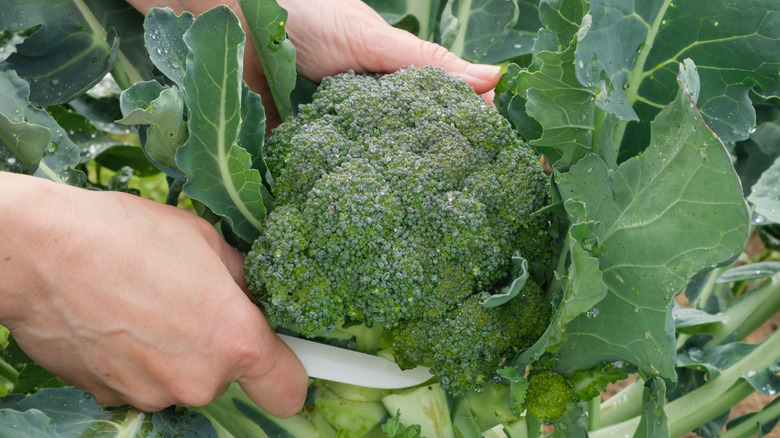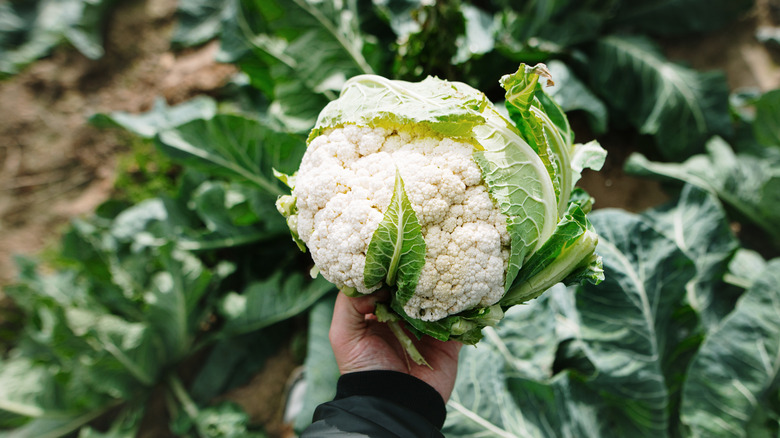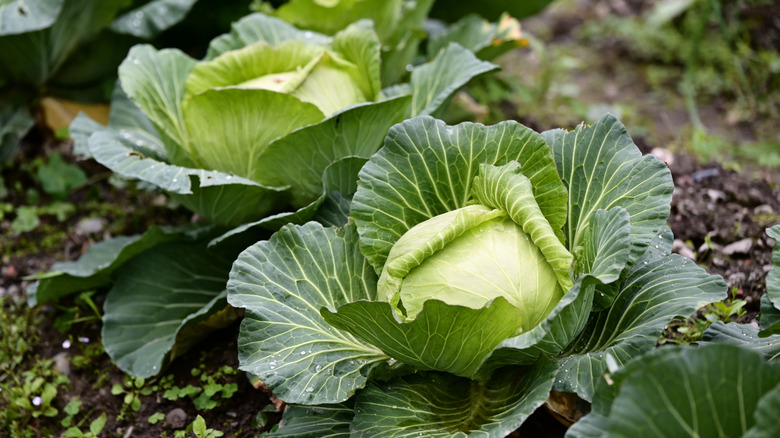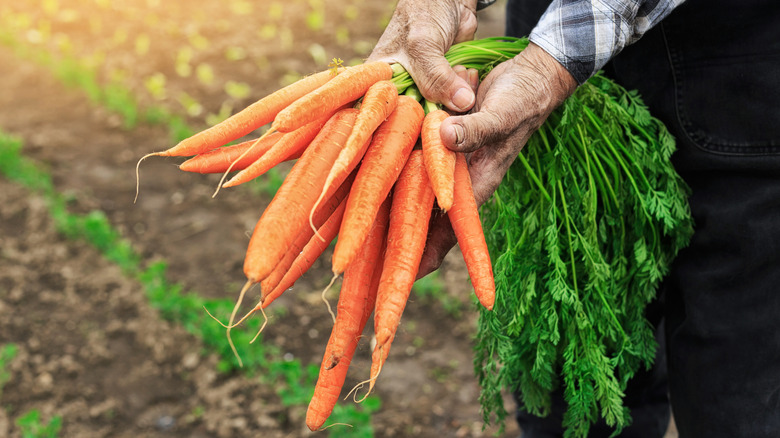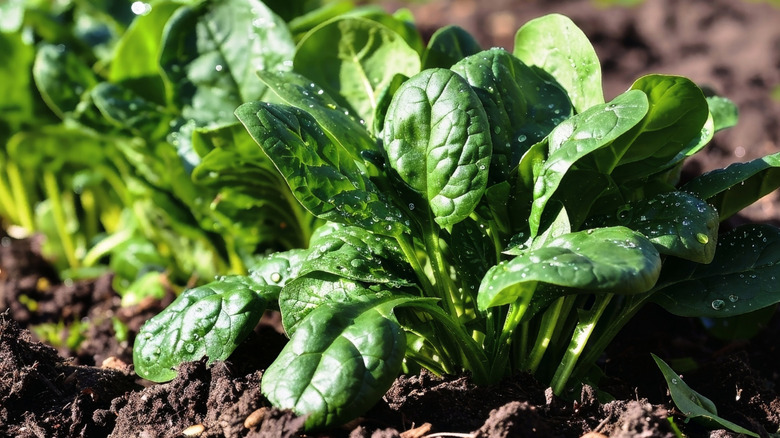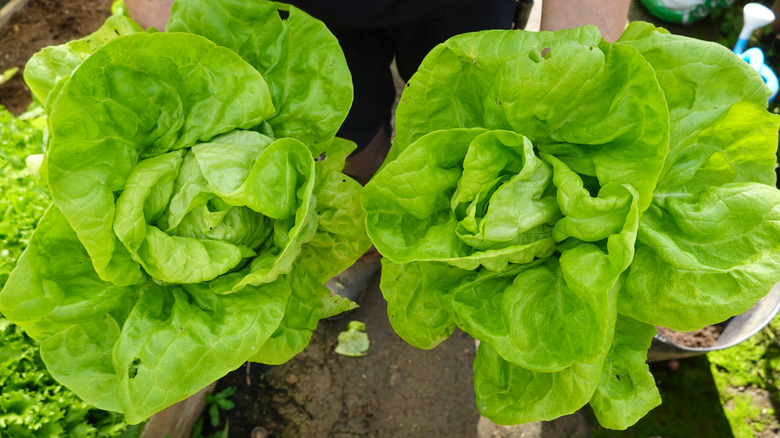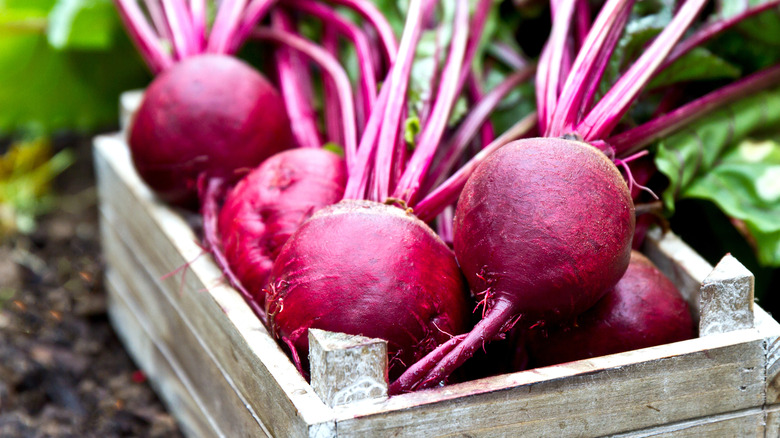12 Garden Crops To Harvest In The Fall For The Best Flavor
The growing season may be winding down, but it's not the end of tasty produce. In fact, the end of the growing season is ripe with fall vegetables that can add flavor and nutrients to your plate. Leafy greens, cruciferous vegetables, and tubers are some of the most popular garden crops to harvest in the fall. Some of these plants even benefit from a cold snap, which can improve the flavor of the crop.
To make the most of the autumn bounty in your garden, it's important to know the right timing to harvest each crop. If you uproot or harvest the vegetable too soon or leave it too long, you risk poor flavor, texture, or both. Keep the average growing time for each plant in mind, but keep a watchful eye on your veggies as they near harvest time. That way, you don't miss the window of opportunity to enjoy the fruits of your labor!
Broccoli is best to harvest before it bolts
A favorite fall crop, broccoli grows best in cool weather. Warm temperatures can cause the broccoli in your garden to start flowering (also known as bolting) and become bitter in taste. Usually, broccoli takes about 60 to 75 days to reach the harvest stage, depending on climate conditions. That means it should be ready to harvest in mid to late fall.
You'll know that broccoli is ready to harvest when the head is 6 to 12 inches in width and full of dark green, tightly closed buds in a compact cluster. If you notice the buds or leaves yellowing, it's time to harvest it right away. Ideally, you should harvest a head of broccoli in the morning when it's still cool out for peak flavor. To do so, grasp the head of broccoli and cut it loose from the plant. If it's early enough in the growing season and you leave a few inches of stalk in the ground, the plant may still produce smaller side shoots.
Cauliflower needs cool but not cold temperatures
Like broccoli, you'll know that cauliflower is ready to harvest based on the size of the head. For this cruciferous vegetable, it will be about 6 inches wide and full of tight bud clusters. It usually takes cauliflower about 60 to 70 days to mature. For the best chance of success and flavor, you'll need to get the timing just right. To grow this popular but picky vegetable in your garden, time it when temperatures are between 60 and 68 degrees Fahrenheit. When you plant cauliflower too soon, warm weather can turn it from sweet and nutty tasting to bitter.
If you succeed at growing cauliflower to maturity, you'll have a tasty, crunchy vegetable to bake or roast for your favorite fall recipes. To harvest it, cut the head free from the stalk using a sharp knife. As a bonus, the leaves of the plant are edible, too.
Cabbage gets sweeter in the cold
Crunchy when you pick it but soft and flavorful when you sauté it, cabbage is a tasty fall veggie you can harvest and cook right away. Or, keep stored for a week or more in cool, dry conditions. Depending on growing conditions, the leafy heads are usually ready for picking around 70 days after planting. Cooler weather is no problem for this crop. In fact, cold temperatures produce a sweeter flavor for cabbage leaves.
The ball is in your court when it comes to deciding when to harvest a head of cabbage. You can pick it as soon as it has a firm feel and you deem it large enough. However, you can also leave it in the garden for several weeks before the risk of deterioration in terms of flavor and texture sets in. When you're ready to pluck it from your garden patch, simply cut the stem close to the cabbage head.
Collards taste better after frost
Collards have a rather slow growing period and reach the harvesting stage somewhere between 75 and 90 days after planting. And while you might be tempted to pick them as soon as the leaves are dark green and 6 to 8 inches in length, you might hold off until the temperatures drop. A snap of cold weather that produces a light frost can actually have a positive impact on the flavor of collards.
The good news is that you don't have to harvest collards all at once. You can pluck off the outer leaves and let the smaller inner leaves continue to grow. However if you desire to pick all of the leaves from the collard plant, that's an option too. If you do this while the plant is young, you can expect the plant to produce a new crop of leaves.
Carrots store up sugar and become sweeter
As a root vegetable, carrots grow sight unseen under the soil but make a great addition to your garden for a fall harvest. Usually, carrots will be ready to eat about 60 to 70 days after planting. If the weather turns cold sooner than you expect, you don't have to worry about pulling them up before the frost. In fact, a hard frost will create a sweeter flavor. That's because a cold snap signals the plant to start preparing for winter by breaking down starches stored in the root of the plant into sugar. When the carrot is harvested after this process unfolds, it tastes sweeter, thanks to this sugar supply.
Carrots are ready for harvesting when the top of the vegetable is about ½ inch in diameter. To harvest your crop, simply grasp the base of the foliage just above the soil line. Give it a firm twist and pull to release the carrot from the ground. If the soil is hard-packed, then make growing carrots a breeze by loosening the soil first to avoid snapping the crop.
Kale gets more flavorful in the fall
A friend of cooler weather, kale plants thrive in crisp temperatures. While warm weather gives it a bitter taste, colder temperatures are what brings about the flavorful, toasty taste that the leafy green is known for. These plants are very hardy and even a hard freeze and temperatures as low as 25 degrees won't damage your crop.
Leaf size is the biggest indicator that lets you know when kale is ready to be harvested. Depending on the variety, the leaves are ready to be picked when they are about 8 to 10 inches in length. You can harvest the entire head of the plant, but since the inner leaves will keep maturing, a progressive harvest is usually recommended. To do that and keep the plant growing throughout the fall growing season, pluck the outer leaves from the base of the plant and let the leaves at the center of the plant remain undisturbed until they grow larger.
Kohlrabi tastes best when harvested small and in the fall
A less familiar vegetable, kohlrabi, is a bulb plant that matures in about 60 days after planting. You'll know it's ready to harvest when the bulb is at least 2.5 inches in diameter. Ideally, you don't want to let the bulb get bigger than 4 inches. This can result in a tough and woody texture with a bitter taste rather than the sweeter taste and crisp texture that kohlrabi is known for. The good news is that you don't have to guess how large your kohlrabi is or dig underground to find out, since this bulb sits above the soil line.
To harvest kohlrabi, simply cut the bulb free from the stem. As a bonus, the leaves are edible, too. Harvested kohlrabi will keep in the refrigerator for several weeks.
Radishes won't be too spicy if the weather is cooler
Radishes grow quickly, giving you a quick turnaround when it comes to fall harvest plants. After planting, you can expect ready-to-eat radishes with an appealing peppery flavor in only 3 to 5 weeks. If your radishes are too spicy, that's an indicator that growing temperatures have been too warm. Cooler weather gives this plant the right conditions for a balanced bite.
Radishes grow underground, but you'll know that this fast-growing vegetable is ready for harvest when the bulb is about 1 inch in diameter (you can pluck one to check on how the crop is doing). To harvest, give a firm pull on the greens. The radish and its greens will be freed from the ground. Plus, since the leaves of the radish plant are edible as well, you'll have two ways to enjoy this fall veggie.
Spinach gets bitter if it bolts
Spinach is a cool-weather crop. So if you want to harvest it for your fall menu, wait until after the heat of summer and plant it in early fall. The leaves are ready for picking in about 60 days, and there's really no wrong time to harvest spinach. Typically, you'll pick the leaves when they are about 5 inches long and considered mature. Smaller leaves that measure around 3 inches long are edible, too. If you prefer the tender flavor of this baby spinach, then harvest this fall crop sooner rather than later. You should definitely harvest spinach before it bolts, since once the plant flowers, the leaves will develop a more bitter flavor.
If you want to harvest spinach for more growth, limit yourself to picking off the larger outer leaves. This allows the smaller inner leaves to continue maturing. If, however, the growing season is nearly done, you might choose to harvest all of the leaves at once.
Leaf lettuces like weather that isn't too warm or too cold
Leafy lettuces, like romaine and red leaf varieties, are garden plants that grow well in cool weather. The weather has an impact on the flavor of this fall crop. So, if you don't want your lettuce to taste bitter, keep in mind that it grows best when the temperature is not too hot or too cold. Generally, between 60 and 65 degrees is ideal, so plant it after the heat of summer has passed. In fact, the temperature drops that occur during fall nights give the leafy harvest a sweeter flavor.
In about 50 days, you'll have mature leaves ready to pick. If you take just the largest outer leaves, the leaves at the center of the head of lettuce will keep producing. To remove a lettuce leaf individually, grasp the leaf near the base of the plant and gently twist and pull. It might also be helpful to use garden shears to snip the individual leaves from the plant. When you cut lettuce to encourage a larger harvest, you'll be able to enjoy fresh, leafy greens throughout the fall growing season.
Beets become sweeter in the fall
Beets are a flavorful fall garden crop that can take about 55 to 70 days to grow to maturity, depending on the climate and variety being grown. The best flavor results when the beetroot grows in cool conditions, since warm weather ones will have less stored sugar. In most growing climates, you should plant this fall crop about 4 to 6 weeks before you expect the first frost. Beets are ready for harvesting when they are anywhere from 1 to 3 inches in diameter.
Since beets are a root vegetable, you won't be able to track their growing progress by peeking into the garden. But that's part of why beets have a reputation for being the best vegetable to grow if you're a lazy gardener. Just keep up with regular watering, and after a couple of months, gently push back the soil to check the crown of the root. When the beet has reached sufficient size, grasp the foliage above ground and pull the beet loose from the soil.
Turnips taste best after frost
Turnips are root vegetables that grow well in cool weather. Planting them too early in the summer heat is one of the biggest mistakes that makes it harder for your turnips to grow, since they grow best when the weather is below 75 degrees. If you plant them a few weeks before the last frost, you'll likely have a successful crop in about 60 days.
Depending on your preference, turnips are ready when they are at least 2 inches or so in diameter. The best flavor comes after the first frost. These turnips will be sweeter tasting and milder. You can harvest smaller ones for a sweeter taste or let them grow a little larger if desired. Be forewarned that turnips can develop a stronger flavor that borders on bitterness as they grow. Harvesting them is done in a similar manner to other tubers; grasp the plant above ground and gently but firmly pull the turnip from the ground, loosening the dirt if necessary. You can also harvest the greens for eating raw or for cooking.

